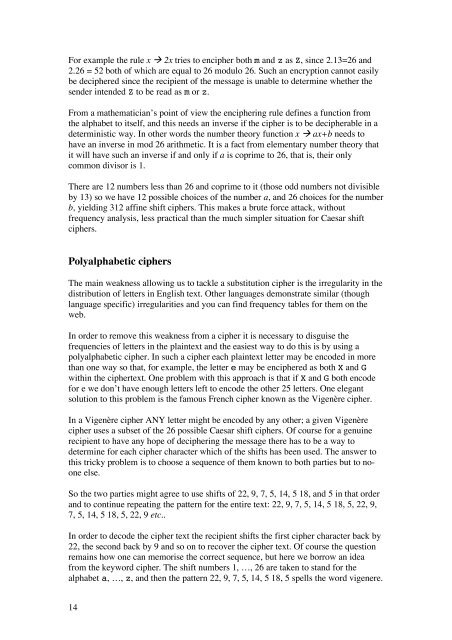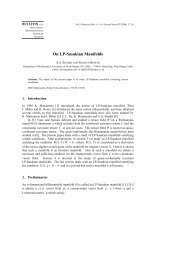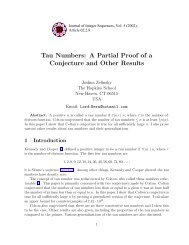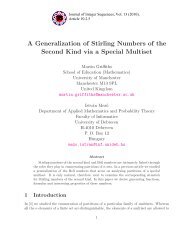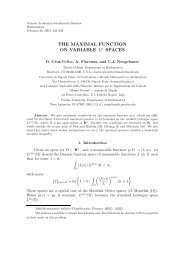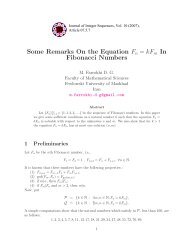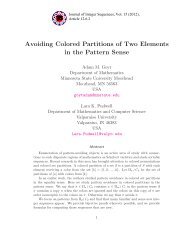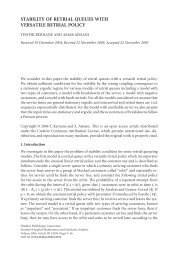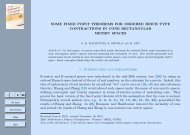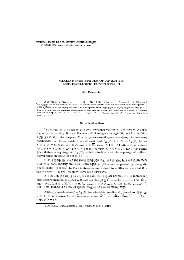Teachers - University of Southampton
Teachers - University of Southampton
Teachers - University of Southampton
You also want an ePaper? Increase the reach of your titles
YUMPU automatically turns print PDFs into web optimized ePapers that Google loves.
For example the rule x ! 2x tries to encipher both m and z as Z, since 2.13=26 and<br />
2.26 = 52 both <strong>of</strong> which are equal to 26 modulo 26. Such an encryption cannot easily<br />
be deciphered since the recipient <strong>of</strong> the message is unable to determine whether the<br />
sender intended Z to be read as m or z.<br />
From a mathematician’s point <strong>of</strong> view the enciphering rule defines a function from<br />
the alphabet to itself, and this needs an inverse if the cipher is to be decipherable in a<br />
deterministic way. In other words the number theory function x ! ax+b needs to<br />
have an inverse in mod 26 arithmetic. It is a fact from elementary number theory that<br />
it will have such an inverse if and only if a is coprime to 26, that is, their only<br />
common divisor is 1.<br />
There are 12 numbers less than 26 and coprime to it (those odd numbers not divisible<br />
by 13) so we have 12 possible choices <strong>of</strong> the number a, and 26 choices for the number<br />
b, yielding 312 affine shift ciphers. This makes a brute force attack, without<br />
frequency analysis, less practical than the much simpler situation for Caesar shift<br />
ciphers.<br />
Polyalphabetic ciphers<br />
The main weakness allowing us to tackle a substitution cipher is the irregularity in the<br />
distribution <strong>of</strong> letters in English text. Other languages demonstrate similar (though<br />
language specific) irregularities and you can find frequency tables for them on the<br />
web.<br />
In order to remove this weakness from a cipher it is necessary to disguise the<br />
frequencies <strong>of</strong> letters in the plaintext and the easiest way to do this is by using a<br />
polyalphabetic cipher. In such a cipher each plaintext letter may be encoded in more<br />
than one way so that, for example, the letter e may be enciphered as both X and G<br />
within the ciphertext. One problem with this approach is that if X and G both encode<br />
for e we don’t have enough letters left to encode the other 25 letters. One elegant<br />
solution to this problem is the famous French cipher known as the Vigenère cipher.<br />
In a Vigenère cipher ANY letter might be encoded by any other; a given Vigenère<br />
cipher uses a subset <strong>of</strong> the 26 possible Caesar shift ciphers. Of course for a genuine<br />
recipient to have any hope <strong>of</strong> deciphering the message there has to be a way to<br />
determine for each cipher character which <strong>of</strong> the shifts has been used. The answer to<br />
this tricky problem is to choose a sequence <strong>of</strong> them known to both parties but to noone<br />
else.<br />
So the two parties might agree to use shifts <strong>of</strong> 22, 9, 7, 5, 14, 5 18, and 5 in that order<br />
and to continue repeating the pattern for the entire text: 22, 9, 7, 5, 14, 5 18, 5, 22, 9,<br />
7, 5, 14, 5 18, 5, 22, 9 etc..<br />
In order to decode the cipher text the recipient shifts the first cipher character back by<br />
22, the second back by 9 and so on to recover the cipher text. Of course the question<br />
remains how one can memorise the correct sequence, but here we borrow an idea<br />
from the keyword cipher. The shift numbers 1, …, 26 are taken to stand for the<br />
alphabet a, …, z, and then the pattern 22, 9, 7, 5, 14, 5 18, 5 spells the word vigenere.<br />
14


